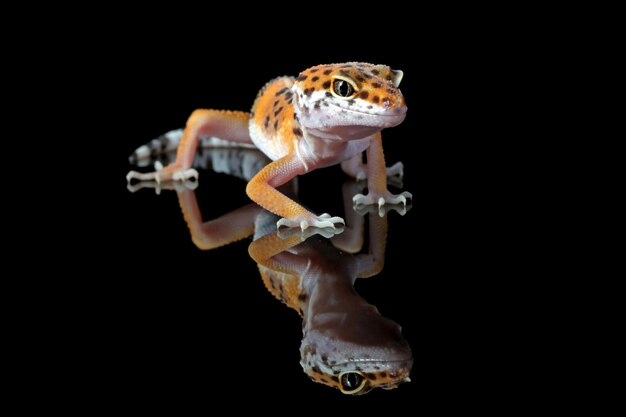Gargoyle geckos (scientifically known as Rhacodactylus auriculatus) are one of the most unique and captivating reptiles in the pet industry. Native to the rainforests of New Caledonia, these geckos are known for their striking appearance and calm temperament, making them a popular choice among reptile enthusiasts. Whether you are a seasoned reptile owner or a beginner looking to learn more, this comprehensive guide will provide everything you need to know about caring for a gargoyle gecko, from habitat requirements to feeding habits.
What is a Gargoyle Gecko?
The gargoyle gecko is a small, arboreal lizard that thrives in tropical environments. It gets its name from the unusual shape and structure of its head, resembling that of a gargoyle. This nocturnal creature features prominent, fleshy “horns” above its eyes, adding to its eerie, ancient appearance. Their skin is rough and textured, usually varying in shades of gray, brown, or orange, with distinct patterns of light and dark that offer effective camouflage in their native habitat.
Gargoyle geckos are part of the Rhacodactylus genus, which includes other gecko species, such as the crested gecko. Unlike other geckos, gargoyle geckos are known for their ability to produce a low, hissing sound as a form of communication and defense when threatened.
Size and Lifespan
On average, a gargoyle gecko will grow to about 7-10 inches (18-25 cm) in length, with females being slightly smaller than males. Their lifespan, when properly cared for, can extend up to 20 years, making them a long-term commitment for any reptile lover.
Gargoyle Gecko Habitat: Creating the Ideal Environment
Tank Setup
Providing a suitable habitat for a gargoyle gecko is critical to its health and well-being. Gargoyle geckos are arboreal, which means they primarily live in trees or high vegetation, so a vertical tank setup mimicking their natural environment is essential.
- Tank Size: A 20-gallon vertical tank is a good minimum size for one adult gargoyle gecko. If you plan on housing multiple geckos, increase the size of the tank accordingly.
- Substrate: Use a substrate that mimics the forest floor, such as coconut husk, reptile carpet, or a combination of both. Avoid using loose substrates like sand, which can be ingested and cause digestive problems.
- Plants and Hiding Spots: Gargoyle geckos need plenty of places to climb and hide. Incorporating live or fake plants, branches, and cork bark will allow the gecko to feel safe and secure in its environment.
- Humidity and Temperature: Gargoyle geckos thrive in humid conditions with a temperature range of 72°F to 80°F (22°C to 27°C). Maintain humidity levels between 60-80%. A misting system or regular hand spraying can help achieve this.
- Lighting: Like most nocturnal creatures, gargoyle geckos do not require intense lighting. Use a low-wattage UVB light for around 8-12 hours a day to simulate day-night cycles, but ensure they have plenty of dark spaces for rest.
Gargoyle Gecko Diet: What Do They Eat?
In the wild, gargoyle geckos primarily feed on a variety of insects, fruit, nectar, and plant matter. In captivity, it’s important to replicate this diverse diet to ensure their nutritional needs are met.
Insects
Gargoyle geckos will readily consume crickets, dubia roaches, mealworms, and waxworms. These should be offered in appropriate sizes relative to the gecko’s body, usually no larger than the width of the gecko’s head.
Fruit
Fruit is a crucial part of their diet. A mixture of pureed fruits such as mango, papaya, banana, and kiwi can be offered as a food supplement. However, fruits should be offered in moderation to avoid overfeeding on sugar.
Commercial Diets
To make feeding more convenient, there are several high-quality, commercially available gecko diets that are designed to meet the specific nutritional needs of gargoyle geckos. These diets are typically made from a combination of powdered fruit, insects, and other ingredients that can be mixed with water to form a paste. Offering this twice a week, alongside live insects and fruit, is a great way to ensure variety and balance.
Supplements
In order to prevent nutritional deficiencies, gargoyle geckos need to be dusted with calcium powder and other reptile vitamins. A calcium supplement should be sprinkled on their food every other day, while a multivitamin supplement should be given once a week.
Gargoyle Gecko Behavior and Temperament
Gargoyle geckos are generally peaceful and easygoing reptiles, making them suitable for beginners and intermediate reptile owners. They are solitary animals, meaning they can be kept alone in a tank to avoid territorial disputes. However, males should never be housed together, as they are known to be aggressive towards one another.
Gargoyle geckos are also nocturnal, which means they are most active during the evening and nighttime hours. They tend to be shy and will often seek refuge in the hidden corners of their enclosure during the day. With patience and gentle handling, many gargoyle geckos can become accustomed to human interaction, though they may still prefer to be left alone during the day.
When threatened or scared, gargoyle geckos may hiss or make other vocalizations as a defense mechanism. In some cases, they may even shed their tail, though this is a rare and extreme response.
Health Considerations for Gargoyle Geckos
Maintaining a healthy gargoyle gecko involves regular monitoring of their habitat, diet, and behavior. Here are some key health issues to watch for:
Obesity
Gargoyle geckos that are overfed or offered high-calcium diets can become obese. Obesity can lead to other health complications, such as metabolic bone disease, which can impact the gecko’s movement and overall health. It’s essential to monitor their food intake and adjust portions to maintain a healthy weight.
MBD (Metabolic Bone Disease)
Metabolic Bone Disease is a common issue in reptiles that occurs due to calcium and vitamin D3 deficiencies. Symptoms of MBD include soft or deformed bones, lethargy, and tremors. To prevent MBD, ensure your gargoyle gecko has access to calcium supplements and UVB light.
Parasites
As with any reptile, gargoyle geckos are susceptible to internal and external parasites. Keeping the enclosure clean and disinfected can help minimize the risk of parasite infestations. Regular vet check-ups are essential to ensure that your gecko remains free of parasites.
Comparison: Gargoyle Gecko vs. Crested Gecko
While both the gargoyle gecko and the crested gecko are popular pet reptiles, they have a few distinct differences. Here’s a quick comparison to help you decide which one is the best fit for you:
| Feature | Gargoyle Gecko | Crested Gecko |
| Size | 7-10 inches (18-25 cm) | 7-10 inches (18-25 cm) |
| Lifespan | Up to 20 years | Up to 20 years |
| Habitat | Arboreal, requires vertical space | Arboreal, requires vertical space |
| Diet | Insects, fruit, commercial diets | Insects, fruit, commercial diets |
| Temperament | Shy but friendly, nocturnal | Shy but friendly, nocturnal |
| Color and Texture | Rough, textured skin, fleshy horns | Smooth, crested skin with horns |
| Handling | Less tolerant of frequent handling | Can tolerate more frequent handling |
| Popularity | Growing in popularity | Extremely popular |
How to Care for Your Gargoyle Gecko: Final Tips
- Keep the Tank Clean: Regularly clean the tank and replace the substrate to prevent bacterial and fungal growth.
- Humidity Control: Ensure that the humidity is consistently maintained through regular misting or an automatic misting system.
- Monitoring Health: Regularly inspect your gecko for signs of ill health, such as changes in appetite, weight loss, or unusual behavior.
- Gentle Handling: While gargoyle geckos are generally calm, handle them gently and infrequently to avoid stressing them out.
Conclusion
Gargoyle geckos are fascinating, low-maintenance reptiles that make a great addition to any reptile lover’s collection. With the right habitat, diet, and care, these unique geckos can thrive and live for many years. Whether you’re a seasoned reptile owner or a newcomer to the world of geckos, the gargoyle gecko offers an exciting and rewarding pet experience.
By understanding their natural behaviors and providing an environment that mirrors their native habitat, you can enjoy the companionship of these ancient-looking creatures while also ensuring their health and happiness.







